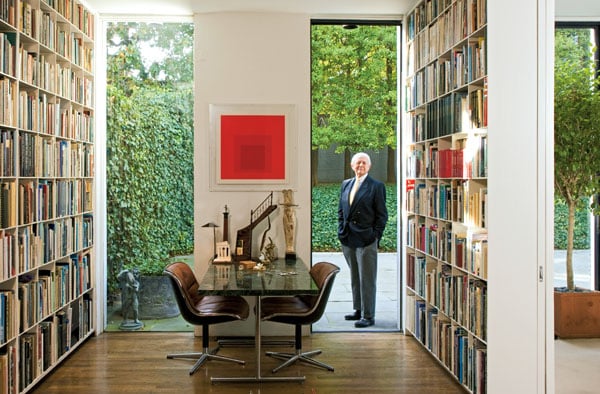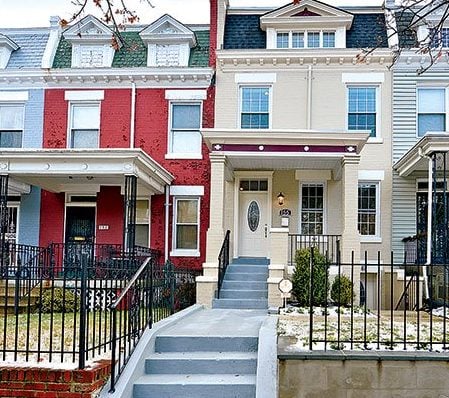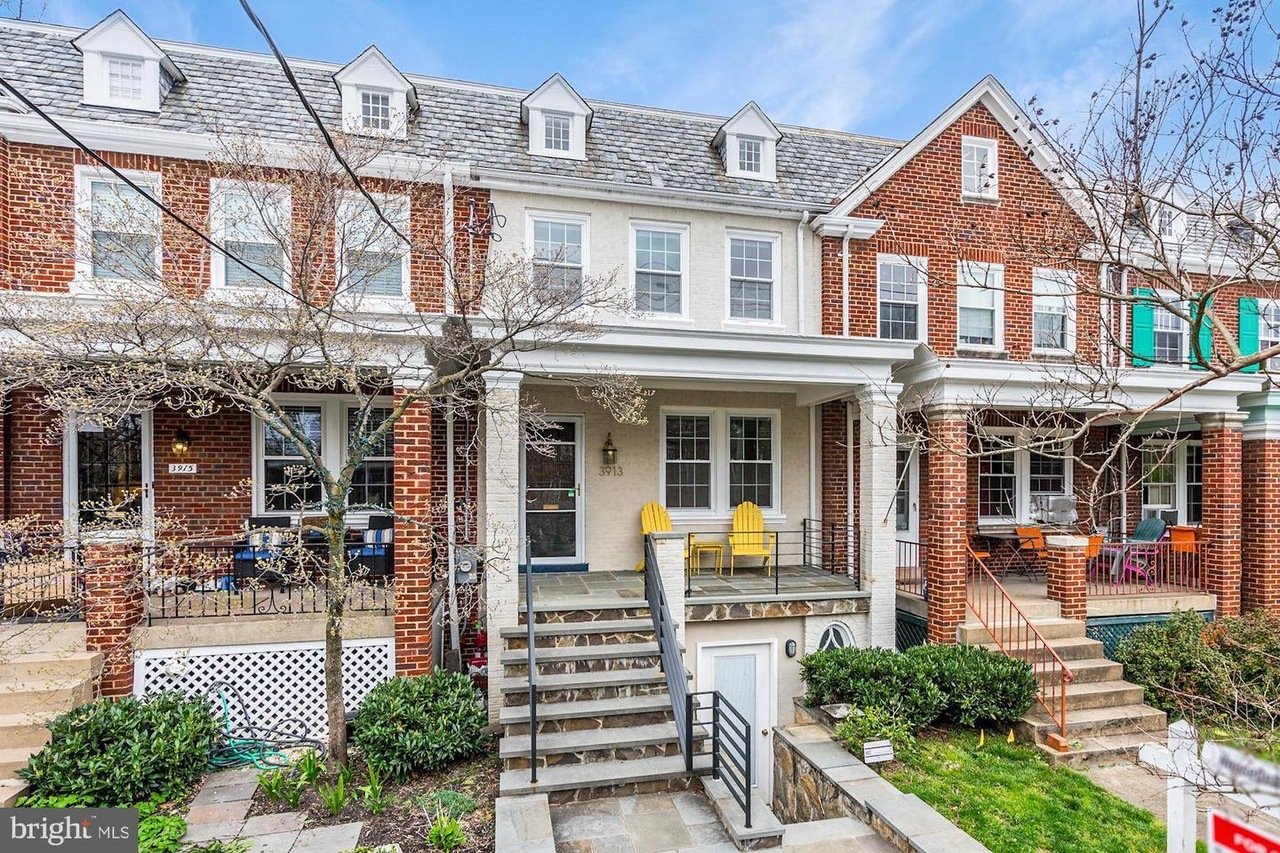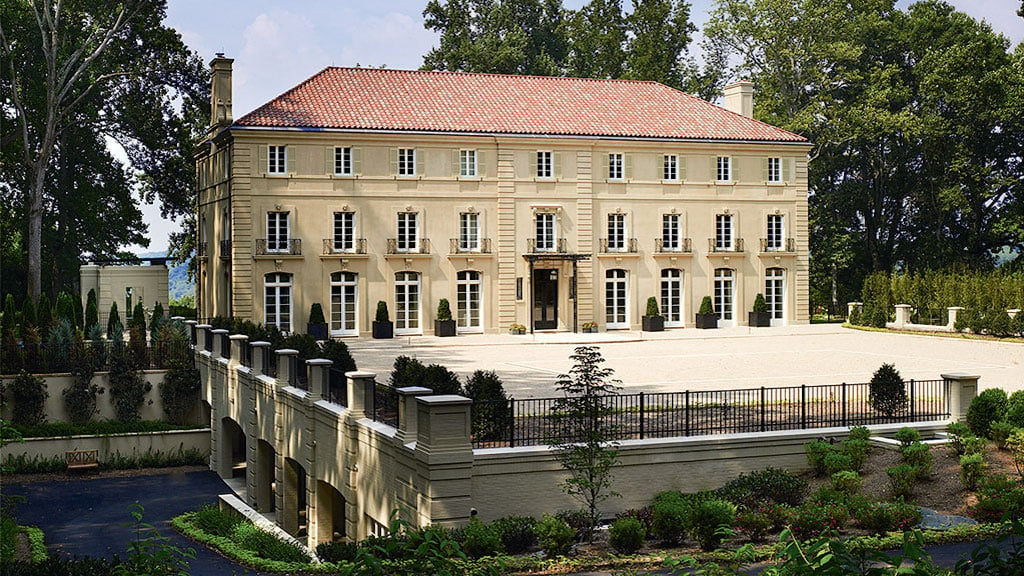Photographs by Ron Blunt.
Every morning, Hugh Newell Jacobsen hugs the Doric column in his foyer. It’s an odd ritual, but he worships the perfect proportions of his ancient mentors.
Three more columns—Ionic, Corinthian, and composite—line the entryway, which is backlit by tall narrow windows. The nine-foot columns command an otherwise modern space he carved out of the Georgetown rowhouse 44 years ago.
A client had commissioned Jacobsen to remodel the two-bedroom, one-bath brick Victorian for a member of the incoming Nixon administration. When the newcomer opted for the suburbs, Jacobsen bought it himself, radically changing the design he’d planned for conservative tastes.
Out went the baseboards and moldings; windows dropped to the floors. In went a bridge connecting the upstairs bedrooms, as well as skylights and lots of bookshelves.
Glass and pure-white walls illuminate all 3,200 square feet of the home, expanded years ago to accommodate three growing sons. The rooms are clearly defined—per Jacobsen’s tenet—but retain an openness. That, he says, has practical as well as aesthetic applications: “Every room has two doorways so that at cocktail parties you can always escape.”
Light flows from the spare, bay-windowed dining room in the front through the glass-walled living room and beyond to an enclosed garden. There, 15 holly trees—a gift to Robin, his wife of 55 years—planted in two rows line the simple rectangle, evoking a park in France—where the couple vacations every year and intends to retire.
Off the living room lies the library and what Jacobsen calls his favorite wall in the house. “Someone once told me that for a minimalist I have a lot of stuff,” he says. “I have about 4,400 books, and I have read all of them.” Most are art and architecture books with more pictures than text, but he does own 1,300 of the Agatha Christie mysteries that he and his wife adore.
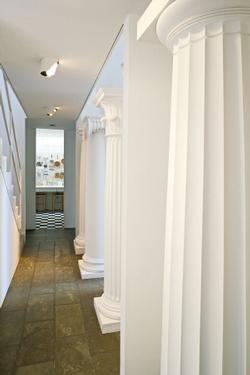
He loves the functionality of his egg-crate bookshelves, which have narrowly spaced dividers. “You are always taking books off the shelves and the rest all fall down,” he says about other bookcases. “With this design, you can remove a whole foot and they won’t.” His signature shelves also provide form and color to the stacked volumes, creating a work of art rivaling those hung on Jacobsen’s other walls.
Jacobsen has earned 133 awards, many for grand projects such as the US embassies in Paris and Moscow. But he is most passionate about the human scale of houses and considers every detail of how his clients will live in them. His own Mies Van Der Rohe glass-and-chrome coffee table is an exact 18 inches from the off-white Scarpa sofas for easy drink-reaching and foot-propping.
The true test of any project, he says, is that it is never remodeled: “I’ve had two torn down but never remodeled.”
Other than the furniture—in the 1960s he had a lot of white plastic—the only real change to his own house in four decades has been the remodeling of a powder room with a glass sink and pedestal that appears to float in a space lined with creamy travertine tiles. Jacobsen feigns chagrin: “It’s embarrassing. I did this 44 years ago, and I’m still doing the same stuff.”
But the debonair 78-year-old knows the home’s visionary design—which some Washingtonians would consider far-out—is what has elevated him to the ranks of the modern masters.
Select Resources
Paint: Sherwin-Williams Pure White.
Contemporary furnishings: Jacobsen likes three retailers—Contemporaria, Knoll, and M2L—saying they offer high quality and great design in contemporary furnishings.
Contemporaria, 3303 Cady’s Alley, Georgetown; 202-338-0193; contemporaria.com.
Knoll, 1150 18th St., NW; 202-973-0400; knoll.com.
M2L, 3334 Cady’s Alley, Georgetown; 202-298-8010; m2lcollection.com.
This article is part of the 2008 Great Home Design package. To see the rest of the package, click here.

